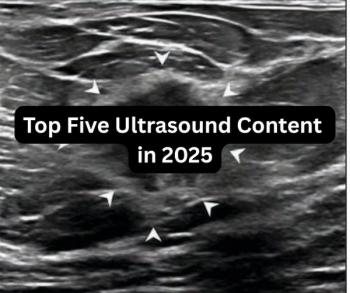
FDA Clears AI-Powered Echocardiography Platform for Detecting Heart Failure with Preserved Ejection Fraction
The EchoGo® Heart Failure device reportedly has an 87.8 percent sensitivity rate and an 83 percent specificity rate for diagnosing heart failure with preserved ejection fraction, an increasingly prevalent but frequently misdiagnosed condition.
Heart failure with preserved ejection fraction (HFpEF) reportedly accounts for 50 percent of 64 million cases of heart failure worldwide and is misdiagnosed in 75 percent of cases.1,2 However, an emerging artificial intelligence (AI)-enabled platform for echocardiography may provide a viable alternative for diagnosing this condition.
The Food and Drug Administration (FDA) has granted
The device, which utilizes AI to analyze millions of pixels in a single echocardiogram image, has demonstrated an 87.8 percent sensitivity rate and an 83 percent specificity rate for diagnosing HFpEF, according to Ultromics. These findings would represent 13.8 percent and 18 percent increases over previously reported sensitivity and specificity estimates with current diagnostic techniques.3,4
Built in collaboration with the Mayo Clinic, the EchoGo Heart Failure platform may allow more timely diagnosis and appropriate treatment interventions for patients with HFpEF, according to Patricia A. Pellikka, M.D, the vice-chair of the Department of Cardiovascular Medicine and director of the Echocardiography Laboratory at the Mayo Clinic in Rochester, Mn.
“This novel solution applies AI to cardiovascular imaging to greatly simplify identification of patients with HFpEF, a diagnosis that can be challenging to make, and allow more expeditious treatment,” said Dr. Pellikka. “HFpEF currently is associated with high rates of hospitalization and mortality. By facilitating early diagnosis and treatment, we can improve the lives of many.”
References
1. Savarese G, Lund LH. Global public health burden of heart failure. Card Fail Rev. 2017;3(1):7-11.
2. Kaplon-Cielslicka A, Laroche C, Crespo-Leiro MG, et al. Is heart failure misdiagnosed in hospitalized patients with preserved ejection fraction? From the European Society of Cardiology – Heart Failure Association EURObservational Research Programme Heart Failure Long-Term Registry. ESC Heart Fail. 2020;7(5):2098-2112.
3. Nikorowitsch J, Bei der Kellen J, Kirchhof P, et al. Applying the ESC 2016, H2 FPEF, and HFA-PEFF diagnostic algorithms for heart failure with preserved ejection fraction to the general population. ESC Heart Fail. 2021;8(5):3603-3612.
4. Sanders-van Wijk S, Aizpurua AB, Brunner-La Rocca HP, et al. The HFA-PEFF and H2FPEF scores largely disagree in classifying patients with suspected heart failure with preserved ejection fraction. Eur J Heart Fail. 2021;23(5):838-840.
Newsletter
Stay at the forefront of radiology with the Diagnostic Imaging newsletter, delivering the latest news, clinical insights, and imaging advancements for today’s radiologists.




























